
Victorian computation
on Stanley Jevons (1835-1882), logician; Charles Babbage (1791-1871), mathematician; and their machines.
When Stanley Jevons had his idea that the processes of logical inference might be mechanised in the 1860s, the last decade of Charles Babbage’s life, he was probably unaware that Babbage, who had had the idea that the processes of mathematical calculation might be mechanised in 1821, had afterwards extended that possibility to embrace algebra and programmable instructions and thus “accomplish the whole of analysis”. By inference this means it would handle logic too, since any system for mechanising logic would have to be algebraic.
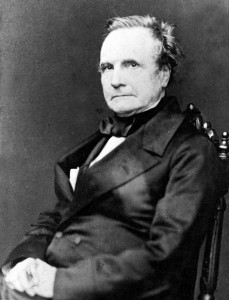
Charles Babbage - the father of the modern computer?
Babbage’s “analytical engine” was fully conceived and designed in the 1830s and 40s– but never made. The question about whether Babbage should or should not be regarded as having invented the computer hinges on the frustrating fact that this is too early for either the logical process envisaged by Jevons or the algebraic method devised by George Boole to have formed part of it, so they are not mentioned by Babbage; but Babbage did know about Boole’s work (published in 1854), and Babbage and his collaborator H. W. Buxton (through whom we have our Babbage collections) repeatedly stressed in the 1860s and 70s the “universality” of Babbage’s analytical machine
Jevons actually corresponded with Boole, leaving less room for doubt that he would have employed Boole’s algebraic logic had he persevered; he did make his machine, and showed it to the Royal Society in 1870 (and we all know where it is now), but he thought that it was “quite as likely to be laughed at as admired” [genuine Jevons quote] — and it was — so he returned to his main interest, economic theory ; Boole likewise found that his 1854 book on the laws of logic was treated at best as marginal if not as a laughable eccentricity by his mathematical colleagues ; for many years after their deaths Boole and Jevons were respected for their mainstream but not very important achievements, Boole in mathematics and Jevons in economics and philosophy, while Babbage (a much more distinguished figure) was considered one of the great deluded eccentrics of the time, famous above all for having failed to make any of the inventions he went on about
As late as 1932 a dicussion among top statisticians and technologists at the Science Museum, London, acknowledged that Babbage’s difference engine (the 1821 calculator idea, the thing we’ve got a chunk of) was a good idea, had he been capable of finishing it, but confirmed that it was still the prevailing opinion that his “analytical engine” idea was crazy
At nearly the same moment, probably unaware of any of this, an eccentric young mathematician named Alan Turing also became interested in logic and also had the idea that it could be mechanised; he devised a thought-experiment in which he envisaged a machine with universal analytical capabilities…
Jevons’s logical “piano” is now regarded as one of the precursors of the computer; “Boolian logic” is now a famous and fundamental mathematical technique, and is the basis for the operation of all computers; and the “universal Turing machine” is now the root of all computational and computer theory
And Babbage… well, he’s just an old eccentric, isn’t he?
(MHS doesn’t have anything of Boole or Turing, though the exceedingly eccentric “chemical calculus” devised by the Oxford professor Brodie, whose papers we have, was inspired by Boole’s logic and dismissed by his contemporaries)
Joseph Wright (1855-1930) was one of the most extraordinary people ever to rise to eminence in the academic world. For he was born in utter poverty, worked from the age of 6 (as a donkey boy in a stone quarry), and remained illiterate until he taught himself to read and write as a teenager. His thirst for education and love of language drove him forward; he studied at the university of Heidelberg, supporting himself as a mathematics teacher; but it was his genius for languages that got him noticed.
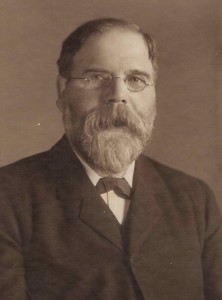
Portrait (Carbon Print) of Joseph Wright, by Elliott & Fry, London, Early 20th Century
In 1891 he was invited to be Deputy Professor of Comparative Philology at Oxford, and succeeded as Professor in 1901. The achievement for which he is best remembered is the English Dialect Dictionary, a monumental six-volume compilation of regional words and expressions, published between 1896 and 1905. The project had been commenced under the medieval philologist Walter W. Skeat, but had proved prohibitively large and ambitious. Wright was undaunted by it, and when the University Press refused to subsidise it he paid for it to be printed from his own pocket, supplemented by a small number of subscriptions.
Yorkshire dialect was his true native speech, and for all his great learning he enjoyed speaking it not, as educated people often do, from amusement but because he believed passionately that dialects were respectable languages in their own right. He proved it by writing a learned phonetic grammar of West Yorkshire dialect, which his colleagues at first thought was a practical joke. He also published grammars of German, Old English, Gothic, and Greek. These have perhaps been superseded, but the English Dialect Dictionary is still, a century later, an essential and greatly respected reference book for scholars of language, folklore, and English social history.
In addition to the usual lexicographer’s procedure of writing words and their details on to slips of paper (estimated at two million), Wright employed the most advanced technique available at the time – the phonograph. The early cylinder machines recorded as well as playing back, and the 12 wax cylinders accompanying Wright’s phonograph contain field recordings of English and Scottish dialect made by Wright and Sir William Craigie in 1900 and 1902. They are among the earliest recordings made of the voices of ordinary human beings.
The phonograph and the blank cylinders were purchased from James Russell & Co., the Oxford music shop (precursor of Russell Acott, which closed down this year after 200 years). They were given to the Museum in 1937 in memory of Wright by his widow Mrs Elizabeth Wright, who had heard that the Museum – which had recently acquired an original Edison prototype – was searching for an ordinary Edison-Bell cylinder phonograph to complete its display. In one sense it is – it is the ordinary standard Edison-Bell model of about 1900; but museum exhibits are not just what they are, they are what they have become through their association and history – and in that sense Joseph Wright’s phonograph is no ordinary phonograph at all.
AVS
Associated objects:
– Joseph Wright’s Dialect Apparatus.
on Joseph Wright (1855-1930), Philologist and editor of the English Dialect Dictionary.
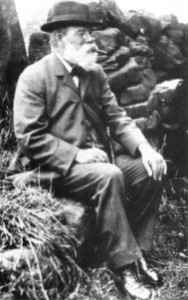
Philologist Joseph Wright smoking his pipe.
Colleagues were sceptical when Professor Max Müller, the greatest philologist in Europe, invited someone called Joseph Wright to be his Deputy Professor of Philology at Oxford. The chap who turned up, keen to start giving his course of lectures on the grammar of Old Gothic (or whatever it was), had a very distinctive West Yorkshire accent, and turned out to have started his academic career at the age of six, as a donkey boy in a quarry.
Their suspicions that Müller had played a practical joke on them may have been allayed, as Wright was an amiable enough fellow, a keen pipe-smoker, and his lectures were actually very good.
But then his first publication as Oxford’s Deputy Professor was a phonetic grammar of the dialect spoken in a tiny Yorkshire village – A grammar of the dialect of Windhill, in the West Riding of Yorkshire : illustrated by a series of dialect specimens, phonetically rendered; with a glossarial index of the words used in the grammar and specimens (1892) – a book set out like a textbook, in completely serious and highly academic fashion.
Could there be doubt any longer? Every Oxford common-room believed, that this was a monumental spoof, pseudo-nonsense worthy of Lewis Carroll ; it was just incredible what a straight face Wright managed to keep when his colleagues ribbed him about it…
AVS
on Frederick Soddy, Nuclear chemist (1877-1956)
You’d like a world with bigger and juicier vegetables, for you and for everyone, wouldn’t you? And for everyone in the world to have enough to eat?
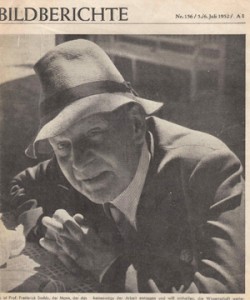
Frederick Soddy, pictured for an article in a German newspaper in 1952.
Well if you didn’t know better and this was 1959, you could achieve this by joining the Atomic Garden Club, one of several organisations aimed to make the world a better place founded under the auspices of the great pioneer of nuclear science and radioactivity, Frederick Soddy (pictured), and headed and run by his eccentric friends Colonel and Mrs Howorth (yes, you can definitely say that Colonel and Mrs Howorth were eccentric – but everything they did was in honour of Frederick Soddy, he was their guru, he was like a god to them …)
The programme they set out to promote was nothing less than to solve the world’s food problems for ever by encouraging farmers and market gardeners to irradiate their crops – which as well as making them grow FASTER and BIGGER, would also, hopefully, produce wonderful new MUTATIONS – so that before you could say John Wyndham the world’s starving would be munching away at radioactive fruit and vegetables and peanuts (I can’t just think whether it’s a vegetable or a fruit, but a peanut the size of a rugby ball was one of their famous successes).
AVS
More details about the Atomic Garden Club can be found on this Garden History Blog.
As well as practising chemistry, Soddy was also a keen mathematician, and Descartes’ Circle Theorem was renamed ‘Soddy’s Theorem’, if not because he discovered it, then because of the eccentric way in which he presented the theorem – in the form of a poem:
The Kiss Precise
by Frederick Soddy
For pairs of lips to kiss maybe
Involves no trigonometry.
‘Tis not so when four circles kiss
Each one the other three.
To bring this off the four must be
As three in one or one in three.
If one in three, beyond a doubt
Each gets three kisses from without.
If three in one, then is that one
Thrice kissed internally.
Four circles to the kissing come.
The smaller are the benter.
The bend is just the inverse of
The distance from the center.
Though their intrigue left Euclid dumb
There’s now no need for rule of thumb.
Since zero bend’s a dead straight line
And concave bends have minus sign,
The sum of the squares of all four bends
Is half the square of their sum.
To spy out spherical affairs
An oscular surveyor
Might find the task laborious,
The sphere is much the gayer,
And now besides the pair of pairs
A fifth sphere in the kissing shares.
Yet, signs and zero as before,
For each to kiss the other four
The square of the sum of all five bends
Is thrice the sum of their squares.
In _Nature_, June 20, 1936
A more easily digestible version of the theorem can be found on this very informative (external) site: http://pballew.net/soddy.html
Our extensive collection of Haldane material — ranging from serious apparatus to archives, from teapot to dust — was all rescued from the private laboratory of J. S. Haldane (d.1930) when his house was demolished in 1967 to make way for Wolfson College. We were told we could take anything except the lawn-mower – the room had been used for thirty years as a lumber room and garden shed. Other things rescued included papers of the famous philosopher and geneticist J. B. S. Haldane (Haldane’s son), which we passed on to a better home, and a stale sandwich, which I eventually and with heavy heart threw away.
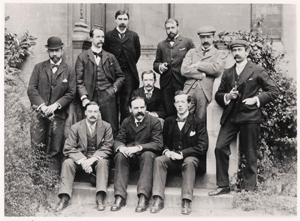
J. S. Haldane (in the centre) with members of the Oxford University Biological Club in 1898
Another thing we couldn’t take, as well as the lawn-mower, was the built-in decompression chamber; J. S. Haldane was a respiration physiologist, whose research included the effects on health of industrial dust, gas-masks during the First World War, and the respiratory dangers of compression and decompression experienced by deep-sea divers. In his experiments on the latter he was his own guinea-pig, and that’s what the decompression chamber was for; he used to lock himself in it and decompress, with his daughter Naomi, then just a little girl, as laboratory assistant. Her job was to watch him through the port-hole window, and when he turned purple, open the door…
Being a very distinguished family (in politics as well as in science) and very clever (as well as eccentric), the daughter was allowed to attend the Dragon School in Oxford, a boy’s prep school, which was just around the corner. She grew up to be the famous novelist and pioneer feminist Naomi Mitchison. When I was sorting the Haldane collection in the 1980s Lady Mitchison (who lived on the Mull of Kintyre) came for a day to help and advise me, and reminisced about some of these experiences; she was then about 90 years old.
AVS
Objects recovered from Haldane’s laboratory included in the Eccentricity exhibition are:
– A teapot with integral strainer
– A box of dust from a tarmacadam works
– Portrait bust of John Scott Burdon Sanderson (Haldane’s maternal uncle)
– Leather wallet belonging to J S Burdon Sanderson





